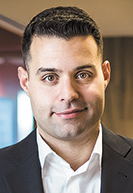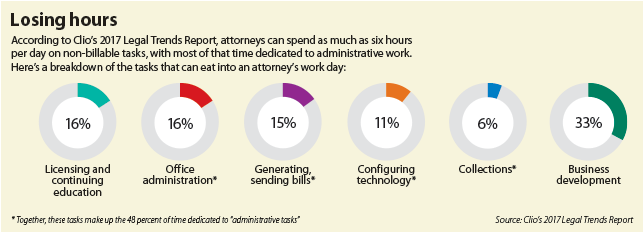Subscriber Benefit
As a subscriber you can listen to articles at work, in the car, or while you work out. Subscribe NowBeth Cox, a partner at the Indianapolis firm Cox & Koons LLP, has set a goal of billing 2.9 hours each workday. Some days she can do it, some days she can’t.
On the days Cox doesn’t reach her billable hour goal, it’s not for a lack of trying. She arrives at work every day between 7:30 and 8 in the morning and stays until at least 5:30 p.m. But there are other tasks demanding Cox’s attention that regularly pull her away from billable work: sending invoices, scheduling appointments, resolving technology issues, etc.
 Cox
CoxCox’s story isn’t unique. A recent analysis of how attorneys spend their workdays showed that only 2.3 hours are devoted to billable tasks. The rest of the time is spent on administrative or business development work, according to Clio’s 2017 Legal Trends Report.
While the Legal Trends Report’s findings may seem alarming, Cox said they aren’t necessarily surprising considering the fast-paced nature of today’s legal world. But rather than dwelling on the lack of time available to complete all necessary work, attorneys and law practice management experts said Clio’s report should inspire legal professionals to evaluate their work style to discern where they can strengthen their time-management practices.
 Psiharis
Psiharis“I think it was a real eye-opener for us,” said George Psiharis, Clio’s vice president of business operations. “It’s also part of some solvable problems, because using the right tools and behaviors can make an impact if attorneys are struggling in this way.”
Leveraging legal technology
Though all legal professionals carry heavy workloads, Psiharis said solo and small-firm attorneys tend to struggle most with finding enough time to complete all of their work. Cox, who serves as chair of the Indianapolis Bar Association’s Solo/Small Firm Section, agreed and said she is often a jack-of-all-trades in her own firm.
Cox also agreed with the survey’s finding that administrative tasks can particularly burden solo and small-firm lawyers, noting that tasks such as billing can eat up a lot of time when a firm does not have designated billing personnel. Clio’s report specifically found that administrative work such as sending invoices, addressing IT issues and general office administration can take up to 48 percent of time attorneys could otherwise spend on billable tasks.
 Fisher
FisherSimilarly, Bryan Fisher, the Indiana State Bar Association’s law practice management coordinator, said he most frequently gets calls from solo and small firm attorneys who want to learn about tools that will make completing their administrative work easier. Through the state bar’s law practice management office, Fisher’s role is to teach attorneys how to leverage legal technology to make their practices run more efficiently.
There’s been an explosion of technology in the legal sector in recent years, Fisher said, but attorneys are often unaware of the resources accessible to them. Legal tech tools are available for a wide variety of needs, he said, from overall practice management to more specific needs.
For example, a program known as Casetext uses artificial intelligence to analyze briefs and produce the relevant caselaw used to build the legal positions in those briefs, Fisher said. That tool is not only helpful when writing briefs, but also for developing a strategy to defend against opposing counsel’s arguments, he said.
On a more basic level, Cox said using electronic calendar software makes it easier for her to keep track of her schedule, another administrative task that seems simple, yet can eat into the day. When she’s in court and a judge wants to set a hearing, Cox said she no longer must go back to her office to check her schedule, then follow up with the court later to set the date. Instead, she can simply pull up her calendar on a phone or laptop and set the hearing then, freeing up more time in the office to focus on client work.
Whether legal tech tools assist with basic tasks such as schedule management or the more complex work of writing briefs, Psiharis said the tools tend to be under-utilized. He said attorneys may have trouble learning the new technology or may resist the increased digitization of the practice of law.
But legal professionals also are hesitant to spend the money necessary to purchase legal technology, Psiharis said. Though the upfront cost of investing in a legal tech tool might seem significant, Psiharis encouraged attorneys to consider the investment in terms of the additional money they could earn when the technology enables them to devote more time to billable work.
Meeting client needs
 While technology can assist attorneys with the administrative duties associated with running a law firm, the process of building a client base tends to require more personal effort. According to Clio’s report, business development accounts for about 33 percent of attorneys’ non-billable time. Further, when asked what they would do with a few extra hours in the day, 41 percent of respondents said they would devote that time to business development efforts.
While technology can assist attorneys with the administrative duties associated with running a law firm, the process of building a client base tends to require more personal effort. According to Clio’s report, business development accounts for about 33 percent of attorneys’ non-billable time. Further, when asked what they would do with a few extra hours in the day, 41 percent of respondents said they would devote that time to business development efforts.
In the Indianapolis legal community, Cox said solo and small firm attorneys try to help one another by referring clients when the opportunities arise. Additionally, she said her firm engages in community events to connect with people.
Such a strategy makes sense in today’s legal market, Psiharis said, considering Clio’s report also surveyed consumers and found 62 percent prefer to find a lawyer through referrals. Paying attention to consumer behavior is key to implementing an effective business development strategy that doesn’t take too much time away from billable work, he said.
In addition to getting referrals, the survey also indicated a consumer is likelier to hire a lawyer if they respond quickly to emails or phone calls. Completing those simple tasks was found to be more effective than devoting time to developing ad campaigns, Psiharis said, indicating that customer service is the key feature prospective clients are looking for.
Individualized approach
While there are dozens of factors to consider when trying to increase law firm efficiency, Psiharis said the best way to start the process is to take inventory of a firm’s current workflow to identify problem areas. From there, an attorney can determine what their biggest needs are — whether that’s help with invoicing, finding a virtual receptionist or developing a new plan for getting client referrals.
Similarly, not every legal tech tool is right for every law firm, Fisher said. The trick to making a worthwhile investment of a firm’s time and money is analyzing needs and selecting the software that most closely aligns with them. If technology is carefully selected to match those individualzied needs, it will likely be more effective at easing the firm’s administrative burden.
Additionally, Cox said seeking advice from other attorneys has been crucial as she’s worked to find ways to devote more time to billable work. Here in Indianapolis, the network of solo and small firm attorneys keeps in regular contact to share information about tools, tips and practices that can make their professional lives more efficient.
“I don’t see people undercutting each other’s business practices,” Cox said. “When we find something that works, we share it.”•
Please enable JavaScript to view this content.
